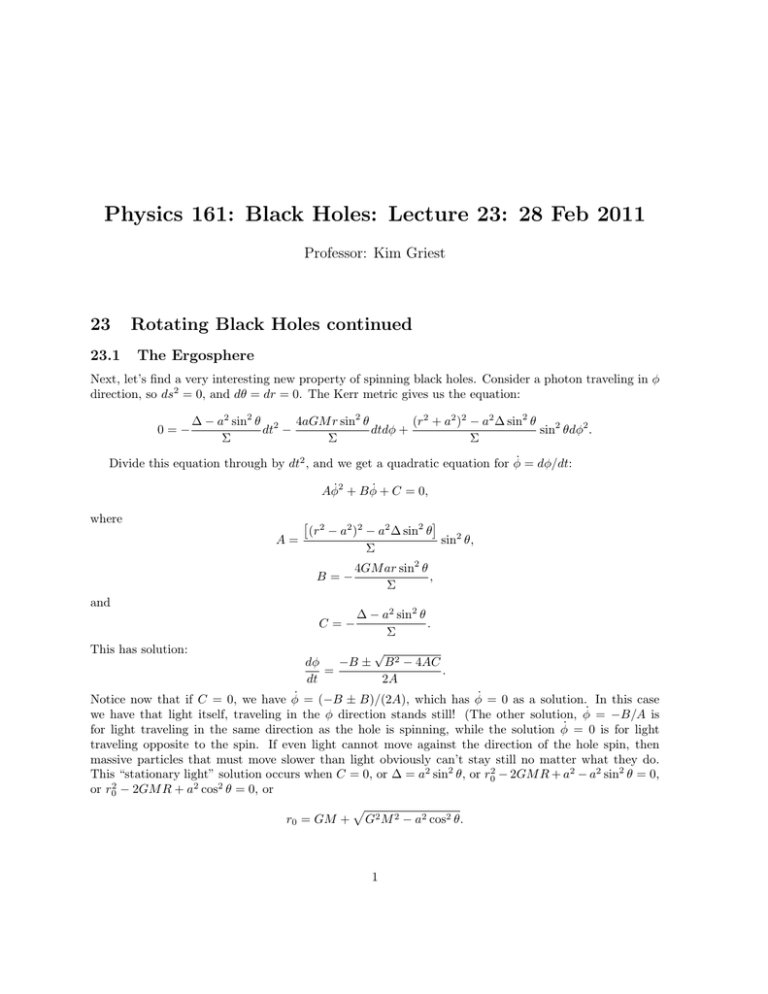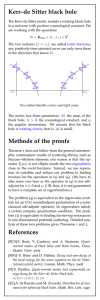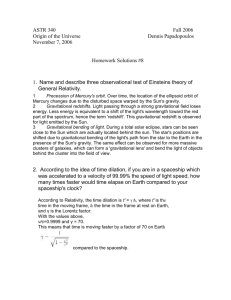Physics 161: Black Holes: Lecture 23: 28 Feb 2011 23
advertisement

Physics 161: Black Holes: Lecture 23: 28 Feb 2011 Professor: Kim Griest 23 23.1 Rotating Black Holes continued The Ergosphere Next, let’s find a very interesting new property of spinning black holes. Consider a photon traveling in φ direction, so ds2 = 0, and dθ = dr = 0. The Kerr metric gives us the equation: 0=− ∆ − a2 sin2 θ 2 4aGM r sin2 θ (r2 + a2 )2 − a2 ∆ sin2 θ dt − dtdφ + sin2 θdφ2 . Σ Σ Σ Divide this equation through by dt2 , and we get a quadratic equation for φ̇ = dφ/dt: Aφ̇2 + B φ̇ + C = 0, where 2 (r − a2 )2 − a2 ∆ sin2 θ A= sin2 θ, Σ B=− 4GM ar sin2 θ , Σ and C=− This has solution: ∆ − a2 sin2 θ . Σ √ dφ −B ± B 2 − 4AC = . dt 2A Notice now that if C = 0, we have φ̇ = (−B ± B)/(2A), which has φ̇ = 0 as a solution. In this case we have that light itself, traveling in the φ direction stands still! (The other solution, φ̇ = −B/A is for light traveling in the same direction as the hole is spinning, while the solution φ̇ = 0 is for light traveling opposite to the spin. If even light cannot move against the direction of the hole spin, then massive particles that must move slower than light obviously can’t stay still no matter what they do. This “stationary light” solution occurs when C = 0, or ∆ = a2 sin2 θ, or r02 − 2GM R + a2 − a2 sin2 θ = 0, or r02 − 2GM R + a2 cos2 θ = 0, or p r0 = GM + G2 M 2 − a2 cos2 θ. 1 √ This is an ellipoidally shaped region region that has a minimum radius of r0 = GM + G2 M 2 − a2 at θ = 0 (north and south poles), and a maximum radius of r0 = 2GM = rS at θ = π/2 (equator). The region inside this ellipsoid is called the ergosphere. Inside this region nothing can stand still. Everything rotates with the hole. The spinning hole actually drags the spacetime around it with it! Light itself going against the rotation direction will be carried backward around the hole. This is called “frame dragging”. If you drop something straight down into a spinning black hole, it will start orbiting the hole even though there is nothing but empty space outside the hole. Actually, this frame dragging occurs even outside the ergosphere, but it is possible to overcome it by using rockets. It actually occurs not just around black holes, but around any spinning object, since the Kerr metric is the description of spacetime in the space around any spinning object. It falls off as r−3 . Thus if you put a very precise gyroscope in orbit around the Earth, the frame dragging will cause it to precess. This is called the Lense-Thirring effect. The size of the precession is very small, only about 0.042 arcsec per year, but there was a NASA satellite called Gravity Probe-B, that was in orbit trying to measure this effect. It seemed to have failed due to experimental errors. We can now picture a spinning hole from the top and from the side. Fig: Spinning Black hole: Kerr metric: Ergosphere, and horizon Considering a maximally spinning hole with a = GM = rS /2, from the top there is the horizon at r = GM = rS /2, just half the normal Schwarzschild radius. Then there is the ergosphere which from the top is a circle of radius 2GM = rS , but from the side goes from just touching the horizon at the north and south poles, to being out at rS at the equator. We will discuss in a minute, why the ergosphere is called by that name. 23.2 Light orbits, inmost stable orbits for Kerr metric In the same way we used the Euler-Langrange formalism to find the geodesics (orbit equations) for the Schwarzschild metric, we can find the geodesics for the Kerr metric. We can then go through the effective potential treatment and find the types of orbits. We won’t spend the time to do this, but the result is that there are two closest stable orbits for massive particles and also two for light rays. Recall for the Schwarzschild metric the light orbit was at r = 1.5rS = 3GM , and the closest stable orbit was at r = 3rS = 6GM . For the Kerr hole these orbits depend upon the value of angular momentum a = J/M , but for maximally rotating holes (a = GM ) the light orbit for light rays going in the same direction as the spin is at r = GM = rS /2 (prograde light orbit), This is the same r as the horizon and the singularity! For light rays going opposite to the spin the light orbit is at r = 4GM = 2rS (retrograde light orbit). For massive particles around a maximally spinning hole, the innermost stable orbit is at R = GM = rS /2 (prograde), and at r = 9GM = 4.5rS for retrograde orbits. Again the prograde (innermost stable circular orbit (ISCO) is at the same r as the horizon. For reference, the effective potential for the Kerr metric is L2 1 a2 GM κGM + 2 + (κ − E 2 )(1 + 2 ) − 3 (L − aE)2 , r 2r 2 r r where L is the conserved angular momentum per unit mass of the test particle (not J the angular momentum of the hole!), and E is the conserved energy per unit mass of the test particle, and where κ = 0 for light ray geodesicis and κ = 1 for massive particles. Recall that we calculated earlier the amount of energy that could be extracted by throwing garbage into a Schwarzschild black hole. We used the geodesic equations to find that a fraction of the rest mass Vef f = − 2 could be converted to useful energy by gradually bringing the garbage down to the innermost stable orbit and collecting the energy that had to be radiated away to get there. Finally the garbage goes down the hole, but we get out the difference between the energy E = mc2 far away and the energypat that last stable circular orbit. For the Schwarzschild case, we found a rest energy fraction fSC = 1 − 8/9 = 5.7% could be obtained. Doing a similar calculation for a maximally spinning rotatingpblack hole we find the maxmimal energy that can be extracted is p a rest energy fraction of f = 1 − 1/3 = 42.2% for the prograde inmost stable orbit and f = 1 − 24/27 = 3.7% for the inmost retrograde stable orbit. Thus we have discovered an even more efficient way of producing energy. Throw garbage into a spinning black hole making sure to do it in the same direction as the hole is spinning. This is the most efficient energy producing device I have heard of. 23.3 Energy extraction from rotating black holes; ergosphere and Penrose process A very interesting property of rotating black holes is that there exist negative energy particle trajectories. If one finds the geodesics and effective potential as described above one finds the energy to be: (Shapiro and Teukolsky equation 12.7.26) E= 2aGM L + (L2 r2 ∆ + m2 r∆ + r3 ṙ2 )1/2 , r3 + a2 r + 2GM a2 where E and L are the conserved quantities found from the Euler-Lagrange treatment of the Kerr metric. If one solves for the regions where E < 0, one finds that it corresponds to what we called the ergosphere. This property is why it is called the ergosphere, since ergo is the Greek word for energy. The ergosphere is also called the static limit, since particles cannot stay at rest inside this surface. The particles which are retrograde inside the ergosphere can have negative energy, but only particles inside the ergosphere can be scattered into geodesics with negative energies. Such negative energy particles always have trajectories that carry them into the black hole, so we can never see them. However, this gives rise to an interesting possible process called the Penrose process that allows one, in principle, to extract energy from a rotating black hole. Suppose, one shoots a massive particle inside the ergosphere, and then at a preprogrammed time it splits into to two particles, one of which has negative energy and one of which has positive energy. Penrose showed that the negative energy particle would go down the hole, but the positive energy particle could escape, carrying with it more energy that it came in with! Ein = Eout + Edown , or Eout = Ein − Edown , which implies Eout > Ein since Edown < 0. This does not violate energy conservation, since it turns out the negative energy particle will slow down the spinning of the hole and reduce its energy. Thus this is a way to extract energy from a spinning hole. In fact, this particular process is probably not too useful astrophysically, because in order to get it to work the relative velocity of the pieces of the splitting particle must be greater than c/2. Fig: Penrose process of extracting energy from rotating black hole 3



